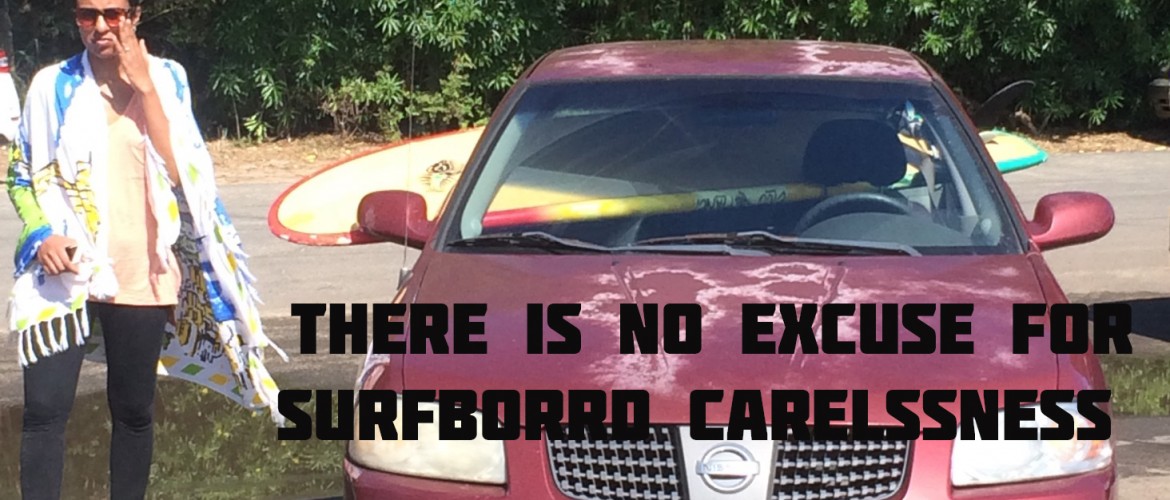How to properly transport your surfboard on or in your car
www.onewavesurf.com
February 1, 2016
Living in Los Angeles and traveling the world, I have seen quite a few creative ways to transport a surfboard. Of course the easiest is to have your board ride inside the car with you to the beach, but even this takes a little thought and planning. If the board has to go on top of the vehicle there is even more to consider.
Right off, I am going to start with some of the don’t in surfboard transportation:
- Do not put your board through the side of your car, the windows or the sunroof. That is just asking for disaster
- Do not slip the board through the trunk without protecting it. A used board bag is about $50, new $100. A board sock $30. Don’t be cheap with your stick, otherwise you are asking for unnecessary dings every time you hit the car brakes.
- Do not put the board inside the car or van all the way against the windshield. If you then close the trunk hard, there is a good chance you will break the windshield with the tip of your board. At towel there is never a bad idea.
- Do not leave your board locked inside the car for long periods. It will get hot, the wax will melt and over time the board itself will delaminate. Likewise, don’t leave it exposed to the sun on the roof of the car for extended periods.
- Do not buy cheap tie-downs for strapping your board to the roof of the car. Spend the extra money for a name brand in the surf industry with a guarantee. I don’t think I have to explain this one 😉
Things to do:
- If the board is inside the car, treat it like a baby. Get a bag for it. Make sure there is space for it to rest comfortably inside without any kind of pressure from doors, armrests or other things that could damage it. PUT A SEATBELT ON YOUR BABY!. It may sound dumb, but in the event of an accident it could prevent damage to both the board, your car and or your face.
- If the board has to go on the roof and you don’t have crossbars or a hard rack system ($200+ often), spend the $40 to play it safe and get a name brand soft roof rack system. Almost any surf shop sells them. Plus these are easily removable. Open all 4 door when you attach the soft racks to your car or you will strap the doors closed. Make sure the straps attaching the rack to your car are tight and in the proper position before putting your board on top of the pads. Then get your board tied down to the soft rack with the smaller set of tie-downs. Double check everything before you get in the car.
- Your board goes on the roof fins up and most people agree fins forward. If you are stacking multiple board make sure the biggest is on first. When strapping boards to your roof or roof racks, make sure everything is flush in line and in the proper position. Otherwise it will shift while driving or worse yet catch wind and could send the boards airborne.
- When you do get the boards tight on the roof and the straps are locked by the release, tie one simple knot around the mechanism and put the excess strap inside the car so it does not blow around while you drive or worse get wrapped in a wheel well.
- if you do have a proper hard rack system with crossbars, the straps hook each side of the crossbar – inside the running racks, in an over under over pattern and then lock them. Don’t forget the pads or padding between your board and the bars. You can even make your own pads out of an old wetsuits and a little duct tape.
In summary, spent the extra $100 to get the board bag and the proper tie-downs or soft racks which can prevent disaster while transporting your board in or on your vehicle. Take the time to get the setup right! Never leave your board leaning against the car or loose on top of it. Also be aware it is not in properly safe place on the road side it could be run over. Wind or the gust from another vehicle passing or something really really really silly could quickly end your surfboard.
If it’s your first time transporting your board it’s not a bad idea to get a second option from an experienced surfer or surf shop employee. Of course, always drive and surf safely and with stoke!
Mahalo!
—
Equipment Vocabulary:
Tie – Downs – The straps designed to hold your boards to your car. They are usually heavy duty material with a strap release mechanism on one end. Sold in most surf shops for about $25-$30 * Please buy local to support your local surf shop!
Strap release – See above. The strap release should only feed the incoming strap in one direction unless opened by depressing one’s thumb in the opposite direction. No matter what system you purchase, read the instructions.
Pads – Foam to cushion the contact between your board and either the roof of the car or the crossbars.
Soft racks – A complete set of tie- downs and pads to strap your boards to the roof of your car. Sold in most surf shops for about $40-$50 – Please buy local!
Hard rack – The most secure and permanent roof system. Some cars come standard with a hard rack, some aftermarket companies like Thule and Yakima sell sets for different models of cars.
Running bars – bars that run the long way across the roof of your car at 6 to 12 ‘o’clock. They are almost always a factory purchase when you get the car from a dealership.
Cross bars –the main component of Hard Racks. These bars connect to the running bars at 3 and 9’ o’clock and cross your roof. This is what you can attach your board to using proper tie down straps. These can be dealership made or often aftermarket companies make them. A soft rack is essentially a temporary crossbar with a pad.
Boardbag – Get one! Support your local shop or support the environment by making one or buying used.



Hi! I’m planning a surf trip to California. Is it legal to transport a surf board inside the car? We’re from Brazil.
Thanks!
Andrezza
As far as I know, Yes.
I transport my board inside my car in a bag and all that… over time sand starts to accumulate inside the car and its a pain to vacuum it. Any tips for that?
Try not to get sand on the bag 🙂